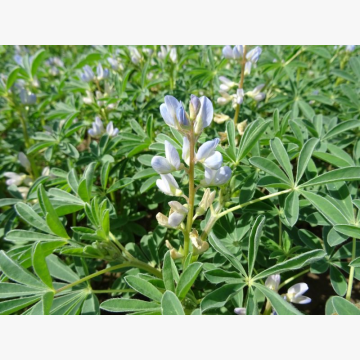FOR CONSULTATIONS APPLY TO:
Commercial director
Lina Smalskienė
tel. +370 618 02 551
e-mail linak@agrolitpa.lt
Sales manager
Tautvydas Kliučininkas
tel. +370 681 35 093
e-mail tautvydask@agrolitpa.lt
Sales manager
Eglė Petkevičienė
tel. +370 626 95 458
e-mail eglep@agrolitpa.lt
Sales manager
Kotryna Nakrošytė
tel.: +370 601 39 282
e-mail kotryna@agrolitpa.lt
DIETA
A sweet lupine with white seeds, suitable for human consumption or green fodder, feeding purposes
- Tall, large-leaved plants
- Large white seeds
- High seed oil and protein content
- Average yield – 3.09 t/ha (UK)-3.14 t/ha (Denmark)-3.652 t/ha (Hungary)-4.156 t/ha (Canada)
- Yield potential – very high (4.94 t/ha) (UK)
- Plant height – 60 cm
- Stems – branched
- Leaves – large
- Flowering – 40 days after germination (in UK) (sown in early April)
- Pod formation – 55 days after germination (in UK)
- Seed maturuty – August 27 (in the United Kingdom)
- In Canada, the seeds matured in 125-141 days from sowing
- Susceptible to anthracnose, fusarium
- Flowers – white (slightly bluish)
- Pods – large
- Seeds – white, flattened, large
- 1000 seeds weight – about 300 g (280-310-341 g)
- High protein content in DM (38-40 %)
- Contains the essential basic types of protein amino acids
- The seeds contain more oil than narrow-leaved lupins
- Does not contain bitter or poisonous substances
- Prepared as protein-rich pulses are used for food
- As long as undried grains from green pods are used, they should be boiled for about 15 minutes until soft
- If dried grains are used, they should be soaked overnight, after draining the soaking water, boiled in clean water for about 40-60 minutes until soft. They can then be used in stews, salads, burgers or crushed into "lupin hummus". Seeds can also be ground into flour, which can be used to make cakes and pancakes. Flour is already used as an alternative to soy in many food products.
- People allergic to peanuts should not eat these lupine seeds
- The flowers attract bees
- Plants fix nitrogen
- Suitable for green manure
- Best grown in drier, warmer regions when grown for grain
- In other regions can be cultivated as fodder crop (for green fodder, silage, grain)
- Can be grown for silage with wheat and triticale (best harvest time was 130 days from sowing (in UK)
- Suitable pH – from 5.0 to 7.8-7.9 (tolerates non-acidic soils)
- Growing lupins consume about 40-60 kg/ha P, 40-60 kg/ha K and 20-40 kg/ha S
- Anthracnose can damage in warm and humid weather
- Protect against aphids and slugs
- Other lupins should not grow close to each other – a minimum isolation distance of 50 m to avoid cross-breeding
- Content of crude protein in DM – 355 g/kg
- Fat content in DM – 104.5 g/kg
- Starch content in DM – 98.5 g/kg
- Fiber content in DM – 110.5 g/kg
- ADF –155 g/kg
- NDF – 184.5 g/kg
- Energy content – 20.9 MJ/kg
*Results of research on lupine seeds in the Czech Republic, 2017 (CHANGES IN BASIC NUTRITIONAL COMPOSITION OF THE PRODUCT (KERNEL) AFTER DEHULLING LUPIN SEEDS)
The varietal parameters may differ from those indicated here when the testing circumstances differ from quondam
Recommended sowing rate: 0,5-0,6mln. seeds/ha, or 150-180 kg/ha (depending on TSW)
Recommended sowing rate when growing for green manure: 190-220 kg/ha
Keravos sreet. 17, Kerava,
LT-38 131 Panevėžys district, LITHUANIA
Enterprise's code 168598128
VAT code LT685981219
Tel. +370 615 11 315
E. mail info@agrolitpa.lt




.JPG)

